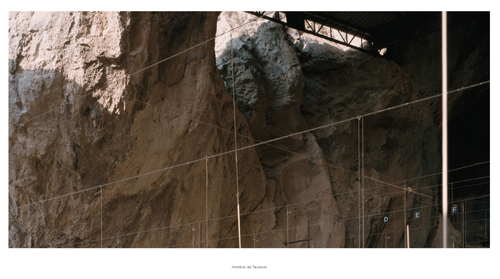|
Bleda y Rosa Hombre de Tautavel. Cueva de l’Aragó (Tautavel Man, Cave in Aragó), 2003 |
| Photograph |
| 124 x 222 cm |
 On their own, a wood, a cave and a rugged Mediterranean coastline would not mean very much, other than a hypothetically sublime beauty applied to the landscape. However, Bleda and Rosa’s photographs express an objectivity that we would never associate with the idea of a romantic, sublime landscape. Not even with a photo-report on nature. Instead, we would be more likely to associate such objectivity with topographic reports or, in the field of art, with a conceptual documentary tradition (Hans Haacke or Dan Graham). Not only because of the objectivity and dryness of the images, but also because of the little key that comes with each one, giving us a clue as to what they are about: “Hombre de Tautavel” (“Tautavel Man”), “Homo neanderthalensis” and “Mandibula de Sitges” (“Sitges Mandible”). In other words, those images with apparently little meaning redirect us to places where archaeological remains of hominids have been found. This happens throughout the “Origin” series. First of all, these works by Bleda and Rosa trigger a sort of penetration into time, between the state of those places now and the time when they were occupied by our ancestors millions of years ago. And then they trigger a displacement of meaning: from the apparent lack of meaning to the recollection stirred by the images of those places. Therefore, not only do Bleda and Rosa stage the basic operation that makes an image much more than just an image, because it is the signified that is at stake, but in doing so they put issues like the recollection, the signifier and the insignificant at stake, too. It is an operation that goes beyond a narrow conception of artistic photography and, consequently, catapults it into the realm of art. Firstly, because the operation of changing signifieds, of plays on meaning, is a basic operation of contemporary art that goes back to Duchamp. Secondly, through the play on references, the desire for dryness and objectivity, in contemporary art. And finally, through a more elusive, more complex element that is wholly contemporary. Because, it is from this operation of objectivised reflection on the image – of a conceptual, linguistic nature – that the story comes, almost without us realising. Ultimately, Bleda and Rosa’s photographs tell a story. The story of what happened and what is not happening, of what it means and what it does not mean. A story constructed from a distance and impossible to narrate, yet which, in Bleda and Rosa’s work – and in contemporary art production – has found its place. |
| David G. Torres |
![]()

